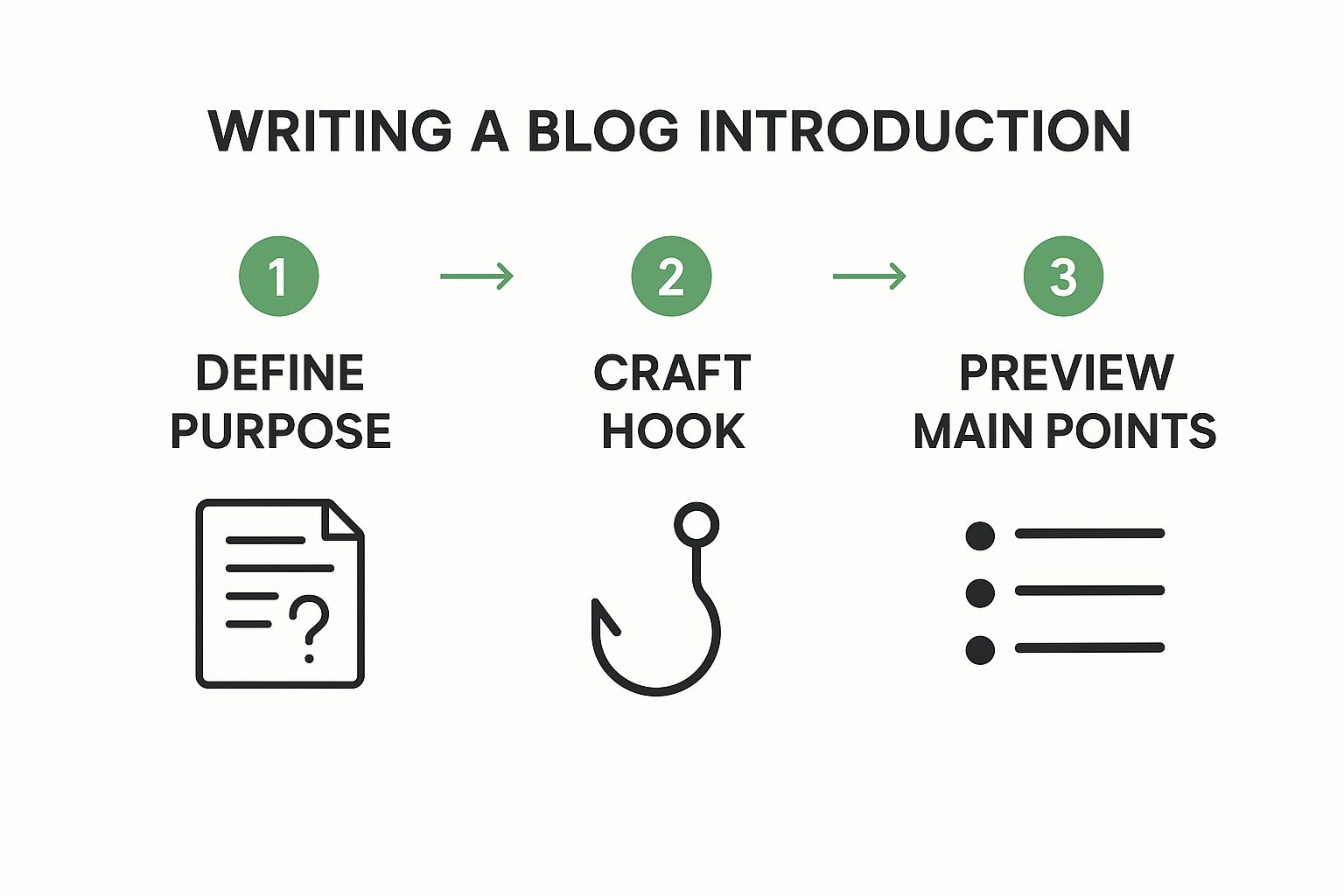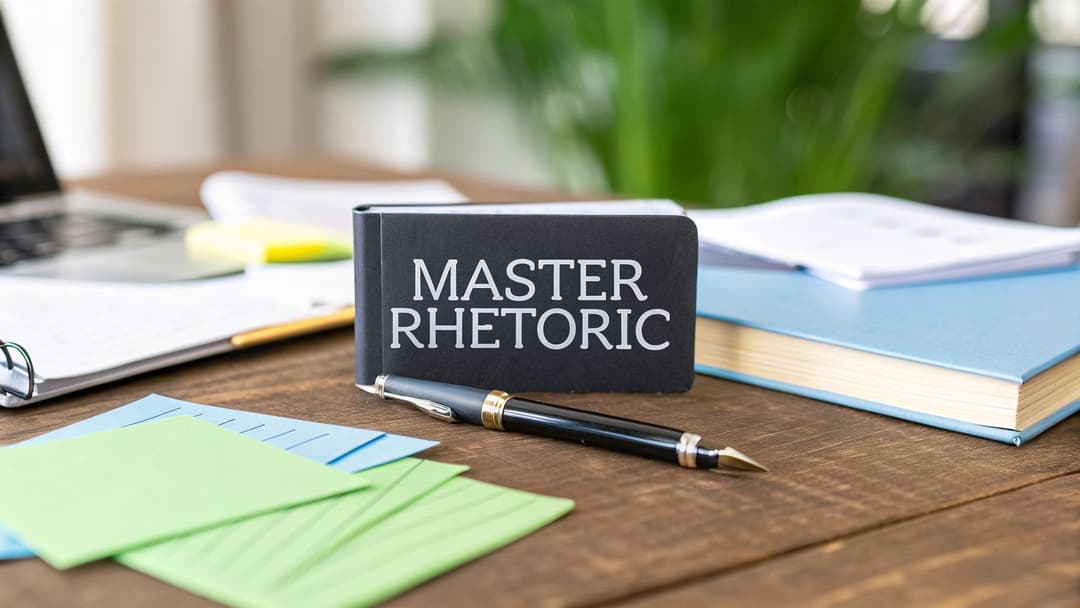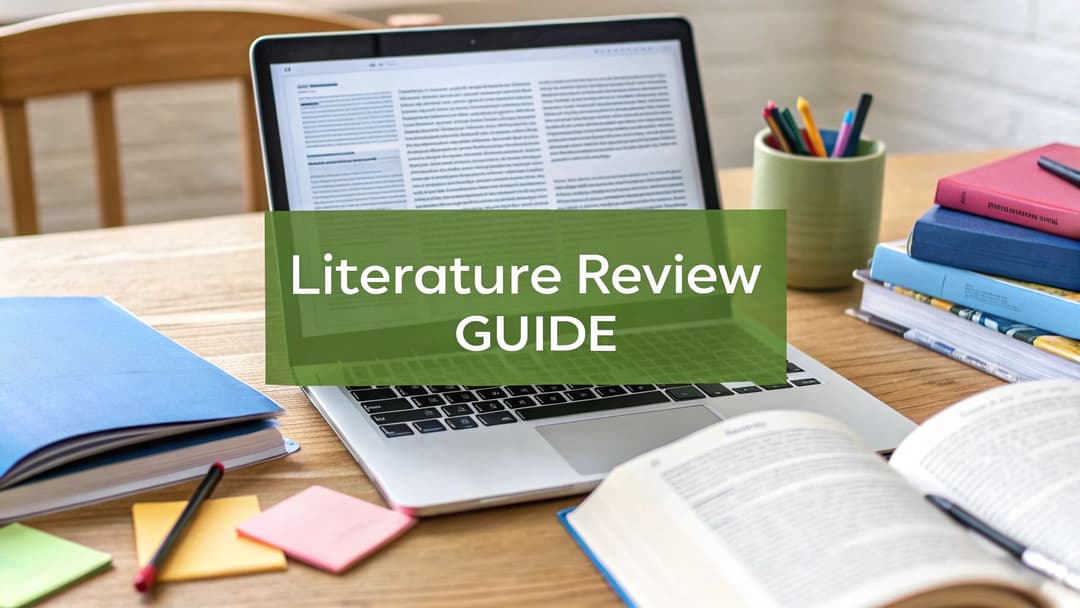
How to Structure a Blog Post for Better Engagement
July 16, 2025
Structuring a blog post isn't just about organizing your thoughts—it's about creating a clear, easy-to-follow journey for your reader. The best way to do this is with a simple hierarchy: an introduction, a body, and a conclusion, all tied together with descriptive headings.
This approach is all about respecting your reader’s time. It follows the classic inverted pyramid model from journalism, where you deliver the most critical information upfront. This ensures every part of your post, from the opening hook to the final call to action, serves a clear purpose.
Your Blueprint for a High-Performing Blog Post
Before you write a single word, you need a blueprint. Think of it like building a house: without a solid foundation and a sturdy frame, the whole thing will eventually fall apart. The goal isn't just to fill the page; it's to guide your reader through your ideas in a way that feels logical and engaging.
A great structure communicates value almost instantly. Let's be honest—most people online are scanners, not deep readers. They're looking for answers, and they want them fast. Your structure should help them find what they need without having to work for it.
This means breaking down your content into digestible chunks using:
- A Compelling Introduction: Your first few paragraphs need to grab the reader and promise a solution to their problem.
- A Well-Organized Body: This is where you make good on that promise, delivering detailed information in a scannable format with clear subheadings.
- A Strong Conclusion: Here, you'll wrap up the main points and tell the reader exactly what to do next.
To make this crystal clear, here’s a quick summary of the core components that form the backbone of any great blog post.
Core Elements of Blog Post Structure
| Element | Purpose | Key Action |
|---|---|---|
| Introduction | Hook the reader and set expectations. | State the problem, promise a solution, and preview the content. |
| Body | Deliver on the promise with valuable information. | Use headings, lists, and short paragraphs to explain your points. |
| Conclusion | Summarize key takeaways and drive action. | Restate the main solution and provide a clear call to action. |
Putting these elements together is what separates a good post from a great one. It’s a framework that builds trust and keeps readers on the page.
Crafting a Winning Introduction
A strong introduction truly sets the stage for everything that follows. It's your one chance to make a first impression. The infographic below breaks down a simple, three-step process for crafting an intro that pulls readers in.

As you can see, a great intro doesn't happen by accident. It starts with a clear purpose, grabs attention with a hook, and then previews what's coming, which helps manage reader expectations from the get-go.
A well-thought-out structure does more than just improve readability; it boosts your credibility and signals to search engines that your content is valuable and well-organized. In fact, mastering these building blocks is one of the most 7 essential elements of good writing to master in 2025.
Your structure also has a direct impact on how much content you need to write. It might seem like a lot of work, but longer, more comprehensive posts tend to perform much better. Research shows that blog posts over 3,000 words attract 138% more visitors than short articles under 500 words. This is exactly why having a solid blueprint is so critical—it allows you to create the kind of in-depth, valuable content that both readers and search engines love.
Crafting an Introduction That Readers Can't Ignore
Your introduction is the most valuable real estate in your entire article. You’ve got just a few seconds to convince a visitor your content is worth their time. A weak opening is a surefire way to send them straight to the back button before you even get to your main points.
So, how do you pull them in?
I’m a big fan of the APP method. It’s a simple framework—Agree, Promise, and Preview—that builds instant rapport and tells the reader exactly what they're getting into. It works like this:
Agree, Promise, Preview: The APP Method
First, you Agree with a problem or feeling your reader is grappling with. This shows you get it. You understand their pain point. For example, you might start with something like, "Staring at a blank page, trying to figure out how to start your next blog post, is a uniquely frustrating feeling."
Next, you Promise a clear, valuable solution. This gives them a powerful reason to stick around. Something like, "This guide will give you a simple framework to write introductions that hook readers every single time." See? Now they know there's a payoff.
Finally, you Preview what they're about to learn. A quick sentence that outlines the key takeaways manages expectations and builds a little anticipation. You could say, "We’ll walk through the APP method, I'll show you how to use powerful hooks, and we'll cover where to place your keywords for the biggest impact."
Weave in Your Keywords Naturally
Knowing how to structure a blog post introduction is also about playing smart with SEO. You’ll want to get your target keyword in there naturally, ideally within the first one or two paragraphs.
This helps search engines figure out what your content is about, but it absolutely cannot feel forced. A good way to do this is to make it part of your problem statement or promise.
Your real goal is to make the reader feel understood and confident that you have the answer they've been looking for. A great introduction isn't just a summary; it's a sales pitch for the rest of your article.
By combining a strong hook with the APP method, you create a first impression that’s genuinely helpful for your readers and optimized for search engines. It’s the best way to ensure your valuable content gets the attention it deserves.
Building a Scannable and Engaging Body

So, your introduction hooked the reader. Now what? The body of your article is where you deliver on that promise. This is the core of your content, the place you prove your point, provide real value, and earn your reader’s trust.
But here’s the thing: even the most brilliant advice will be completely ignored if it’s trapped in a dense wall of text.
We have to accept how people read online. They skim. In fact, some studies show that as many as 79% of users scan web pages instead of reading every single word. If you don't structure your post for the skimmers, you’ve already lost most of your audience.
Use Headings as Your Roadmap
Your best friends here are clear headings (H2s) and subheadings (H3s). Think of them as signposts that guide your reader through the article. They break up your main topic into logical, bite-sized pieces.
Done right, a reader should grasp the entire flow of your argument just by reading the headings.
For instance, instead of a giant section titled "Improving Writing," you could break it down with more specific H3s:
- Focus on Shorter Paragraphs
- Incorporate Bullet Points and Lists
- Use Bold Text for Emphasis
This simple hierarchy makes your content far less intimidating and helps readers jump to the sections that matter most to them.
Keep Paragraphs Short and Sweet
This might be the single biggest mistake I see new writers make: long, chunky paragraphs. On the web, that’s a recipe for disaster.
A good rule of thumb is to stick to one to three sentences per paragraph. This creates plenty of white space, which is much easier on the eyes—especially for the majority of people reading on their phones.
Writing in short bursts also forces you to be concise. You make one clear point, then move on. It sharpens your writing and makes it punchier. This is a core skill that can seriously speed up your process, and it’s a key part of learning how to write faster and better in general.
Key Takeaway: The goal isn't just to share information; it's to ensure that information is easily consumed. Short paragraphs, clear headings, and visual breaks are your best allies in this effort.
Finally, don’t forget to mix in other visual elements. Use bullet points for features or tips and numbered lists for instructions. A blockquote, like the one you just read, is perfect for highlighting a critical takeaway. These little formatting tricks break up the monotony and give your reader’s eyes a place to rest, keeping them engaged all the way to the end.
Writing a Conclusion That Inspires Action

A great blog post shouldn't just fizzle out at the end. Your conclusion is your final opportunity to drive your point home and guide the reader toward a meaningful next step. An abrupt ending feels incomplete, but a strong one makes your entire article stick.
Think of it like the final, firm handshake after a great conversation. You want to leave a lasting, positive impression. The best way to do that is to drop the tired, weak phrases we all know, like "in conclusion" or "to sum up." Instead, your goal is a closing statement that feels both confident and intentional.
The job here is twofold: briefly recap the core solution you offered and then present a clear call to action (CTA). This is where a well-structured blog post really shines, as every section has been building up to this final moment.
Crafting a Compelling Call to Action
Your CTA is what connects your content to your business goals. It's the moment a passive reader becomes an active participant. To make it work, it needs to be direct, clear, and perfectly aligned with what the reader just learned.
For example, if you just wrote a killer post on email marketing, a CTA like "Download our free email template checklist" is a no-brainer. It's the natural next move for someone who just soaked up all your advice.
The best CTAs don't just ask for something; they offer more value. Frame it as the next logical step in your reader's journey, making it an easy and obvious choice for them to make.
Here are a few different kinds of action you can prompt:
- Spark a Discussion: Ask a direct question to get the comments section buzzing. Something like, "What's the biggest hurdle you face when structuring your posts? Let me know below!" works wonders.
- Generate Leads: Offer a content upgrade—think a downloadable guide or a checklist—in exchange for an email.
- Build Your Community: Invite readers to join you on social media or subscribe to your newsletter for even more tips.
Pick one main CTA and make it impossible to ignore. When you end with purpose, you give your content the impact it deserves and complete the reader's journey.
Breathing New Life into Old Content

A blog post's structure should never be set in stone. Think of your published articles as living assets. One of the smartest things you can do for your blog's health is to revisit and refresh them over time. This process, often called a content audit, is all about finding older posts that could be performing way better with a quick structural tune-up.
This kind of proactive maintenance sends a powerful signal to search engines that your content is fresh, current, and authoritative. It’s also an incredibly efficient strategy. While publishing new content frequently is important, simply updating what you already have can deliver massive results.
The numbers don't lie. Research shows that while companies publishing 16+ posts per month can see 3.5 times more traffic, updating older content can lead to 2.5 times better results all on its own. It’s a huge testament to the value of keeping your content accurate and relevant. You can dig into more of these fascinating blogging traffic statistics on amraandelma.com.
How to Find Your Best Update Candidates
So where do you start? Pop open your analytics. Look for posts that get decent traffic but have a high bounce rate or low time-on-page. These are your prime targets. It means people are interested in the topic, but the content itself is failing them somehow—usually because of a weak structure or outdated info.
Also, keep an eye out for posts with obviously dated information. Did you write about a "2022" trend that’s now totally irrelevant? That's the perfect opportunity for a refresh.
The goal isn’t to rewrite everything from scratch. You're looking for strategic, high-impact changes that boost the reader experience and SEO performance with the least amount of effort.
A few quick things to look for include:
- Outdated Statistics: Swap old data for the latest figures you can find.
- Broken Links: Run a quick check and fix any links that lead nowhere.
- Missing Information: Add new sections that answer follow-up questions your readers might have today.
Making High-Impact Structural Changes
Once you’ve picked a post, it’s time to get to work on the structure.
Start with the formatting. Are there massive paragraphs you can break up? Can you add more headings, bullet points, or even a blockquote to make the whole thing more scannable? These small tweaks make a huge difference in readability.
Next, consider adding entirely new, relevant sections with their own H2 or H3 headings. For example, if you wrote a guide on "social media tips" a few years ago, you could add a brand new section on "Using TikTok for Business." This adds immediate value for the reader and helps you start targeting new keywords.
Making these revisions systematically is what separates a good effort from a great one. Using a detailed writing revision checklist can help you cover all your bases, from the overall structural flow to the final proofread. It’s how you turn a good post into a great one that performs for years to come.
Common Questions About Blog Post Structure
Even with a solid plan in place, a few questions always seem to pop up when it comes to structuring a blog post. Let’s clear the air on some of the most common ones so you can get back to writing with confidence.
How Many H2 Headings Should a Blog Post Have?
This is a great question, but there’s no magic number. A good rule of thumb I always follow is to use one H2 for each big idea or major topic in the article.
So, for a 2,000-word post, landing somewhere around 4 to 6 H2s usually feels right. This breaks your content into neat, scannable chunks that readers can actually digest without feeling overwhelmed.
More importantly, it’s a huge signal to search engines. Good headings help them understand the hierarchy of your content. The key is just making sure every heading clearly tells the reader (and Google) what they're about to learn.
A well-structured post with clear headings (H1, H2s, H3s), short paragraphs, and lists is easier for both users and search crawlers to digest. This often leads to better rankings, longer time on page, and lower bounce rates—all powerful SEO signals.
Where Is the Best Place for a Call to Action?
Your main call to action (CTA) almost always belongs in the conclusion. Think about it: you’ve just spent the entire article delivering value and building trust. By the end, your reader has the full picture and is perfectly primed to take that next step.
But don’t stop there. It's smart to sprinkle in contextual CTAs where they feel natural and genuinely helpful. For instance, if you mention a specific tool, that's a perfect spot to link out to a detailed review you wrote. The goal is to be helpful, not pushy.
Ultimately, a good post structure is all about guiding the reader. When you do it right, the final CTA doesn’t feel like a sales pitch—it feels like the next logical step in their journey.
Ready to transform your AI-generated drafts into polished, human-like content? Natural Write is a free tool that refines your text in one click, ensuring it bypasses AI detection while preserving your original ideas. Perfect your blog posts, essays, and marketing copy with confidence. Try it now at https://naturalwrite.com.


